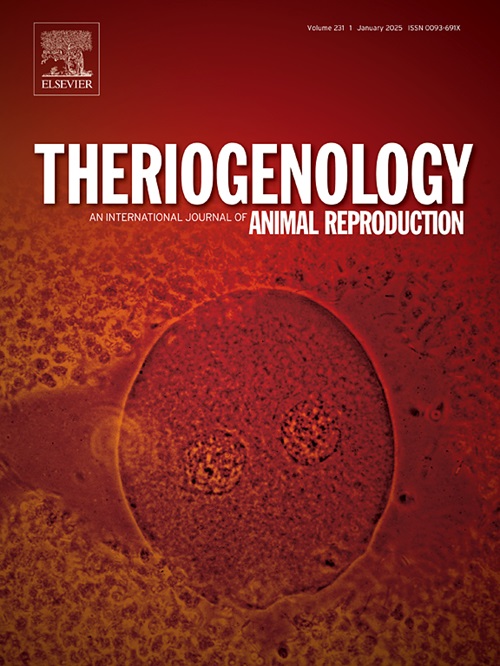Pseudopregnancy in dromedary camels: Characterization, prevalence, and clinical and hormonal properties
IF 2.4
2区 农林科学
Q3 REPRODUCTIVE BIOLOGY
引用次数: 0
Abstract
Pseudopregnancy is the development of signs of pregnancy in the absence of an embryo or fetus. The objectives of this study were to characterize pseudopregnancy in dromedary camels, determine its prevalence in camel farms and practice, identify associated risk factors, and describe its clinical and hormonal properties. The prevalence of pseudopregnancy on 100 camel farms with 4264 total female camels was determined to be 2.07 % (86/4264) overall, while the rate among infertile animals was 17.68 % (1385/7833). The genital tracts of 58 pseudopregnant female camels were examined, and their breeding histories were examined. Serum concentrations of estradiol-17 β (E2), progesterone (P4), and prolactin (PRL) in these animals were assessed. Five cyclic camels and five in early pregnancy were used as control subjects. Signs of pseudopregnancy included being anestrous, refusing to mate, and adopting a stiffened posture—with the head held high and the tail cocked—when approached by a male. Normal pregnancy-associated mammary and abdominal changes were absent. Risk factors associated with pseudopregnancy included age (odds ratio [OR] = 21.63, P = 0.0001) and a history of reproductive disorders (OR = 4.155, P = 0.042). Based on their P4 levels, the pseudopregnant camels were classified as either typical (high P4, 16/58, 27.59 %) or atypical (low P4, 42/58, 72.41 %). The main clinical findings in the camels with typical pseudopregnancies were a narrow/closed cervix (56.25 %), clinical endometritis (CE; 43.75 %), and pyometra (31.25 %), while those with atypical pseudopregnancies exhibited CE (50 %) and luteinized follicles (43.1 %). The pregnant camels had significantly (P = 0.0001) higher serum P4 concentrations (2.44 ± 0.32 ng/mL) than the pseudopregnant (0.68 ± 0.12 ng/mL) and cyclic camels (0.16 ± 0.01 ng/mL). Serum E2 levels did not differ significantly among the pseudopregnant (43.2 ± 1.05 pg/mL), pregnant (47.72 ± 4.06 pg/mL), and cyclic (40.72 ± 1.03 pg/mL) camels. The pregnant camels had a significantly (P = 0.04) higher average serum PRL concentration (3.61 ± 0.45 ng/mL) than the pseudopregnant (2.77 ± 0.12 ng/mL) and cyclic camels (2.18 ± 0.11). In conclusion, pseudopregnancy in camels exhibits the same external signs that characterize pregnancy, but pseudopregnancy involves an absence of edema of the udder, milk production, and high PRL levels. We propose a division of pseudopregnant camels into typical and atypical classes, depending on whether they have high P4 levels. Pseudopregnancy is associated with a high incidence of other reproductive disorders, particularly in older camels.
求助全文
约1分钟内获得全文
求助全文
来源期刊

Theriogenology
农林科学-生殖生物学
CiteScore
5.50
自引率
14.30%
发文量
387
审稿时长
72 days
期刊介绍:
Theriogenology provides an international forum for researchers, clinicians, and industry professionals in animal reproductive biology. This acclaimed journal publishes articles on a wide range of topics in reproductive and developmental biology, of domestic mammal, avian, and aquatic species as well as wild species which are the object of veterinary care in research or conservation programs.
 求助内容:
求助内容: 应助结果提醒方式:
应助结果提醒方式:


